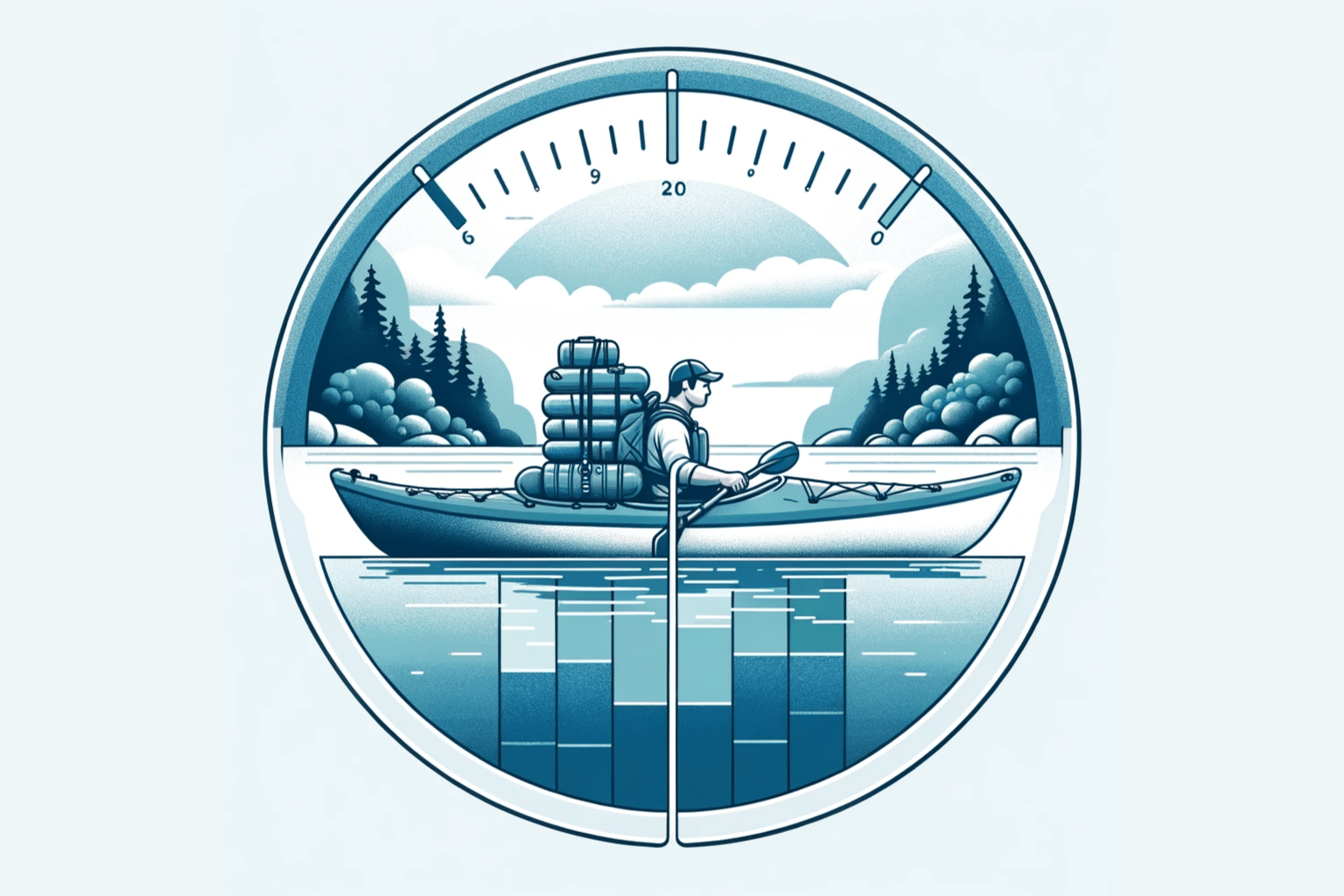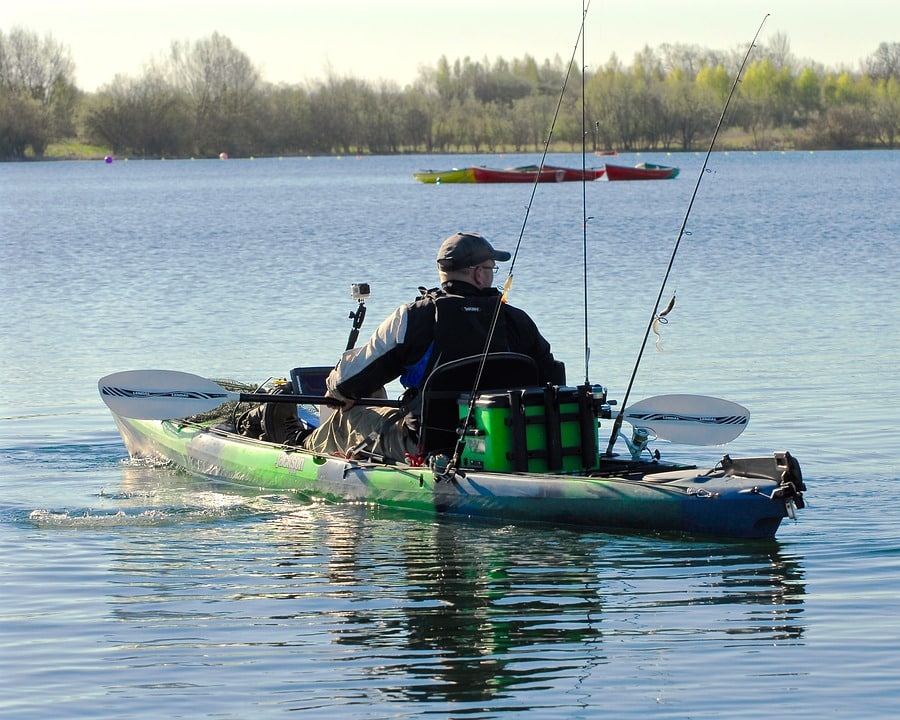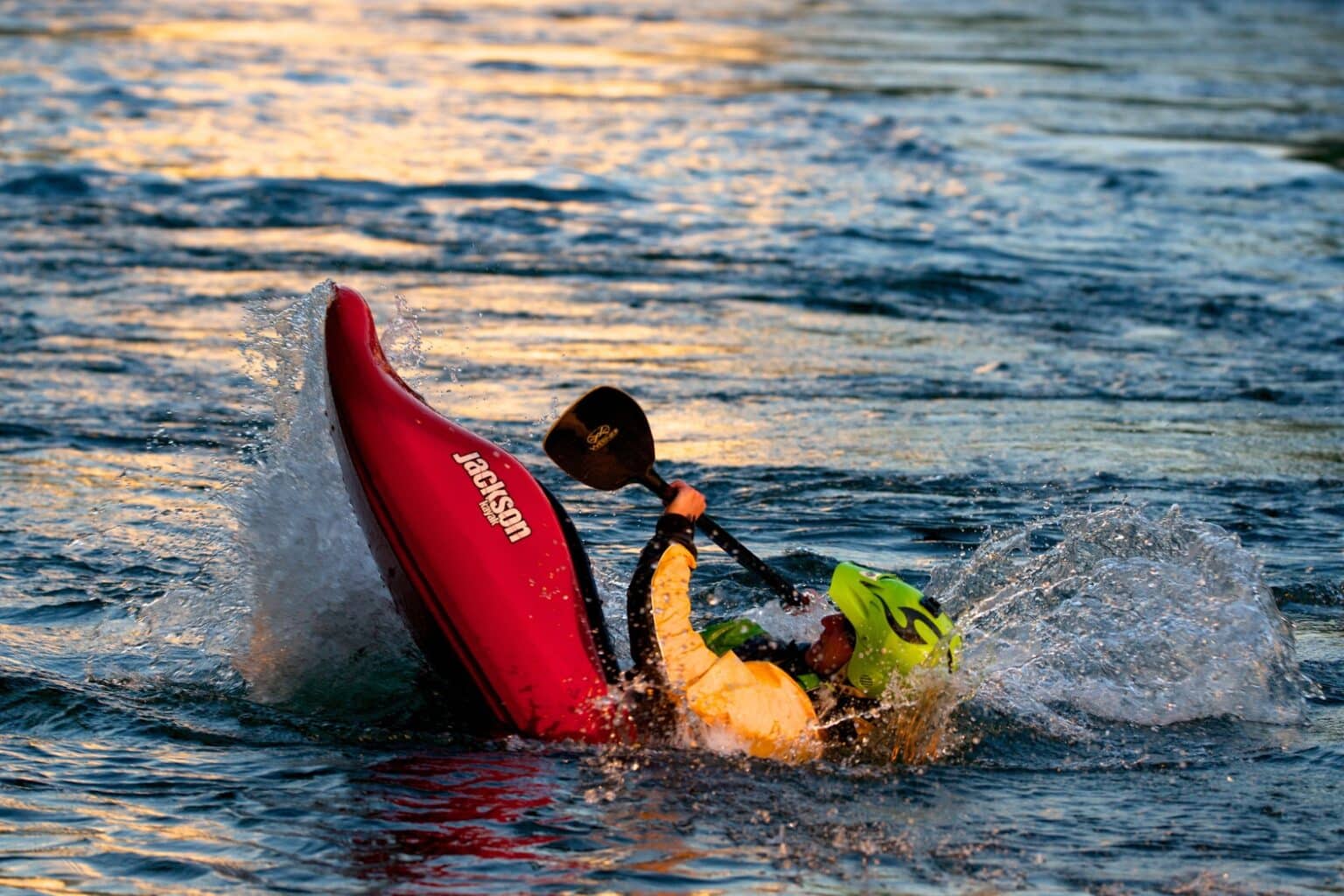Have you ever wondered just how much weight your kayak can hold before it becomes more of a submarine than a vessel? The kayak weight limit is a crucial figure, pivotal for your safety and the kayak’s performance. It dictates not just how much gear you can bring along but also affects your maneuverability and stability on the water.
Understanding these limits is key: a kayak’s weight capacity can range widely, influenced by its design and intended use. Whether it’s a sleek racing model or a sturdy fishing kayak, each has a set limit to ensure peak performance and safety. Knowing these numbers will keep you afloat and ensure a smooth paddling experience.
Ready to dive deeper into the world of kayaking and learn how to maximize your time on the water within these limits? Let’s set sail to understand kayak weight limits and how to choose the right kayak for your aquatic adventures.

Key Takeaways
☑️ What determines a kayak’s weight limit? The design, type, and material of the kayak establish its weight capacity, ensuring safety and optimal performance.
☑️ How much weight can a typical kayak hold? Weight limits vary by kayak type, with most recreational kayaks handling between 250-300 lbs and specialized kayaks more or less, depending on their design.
☑️ Why is it important to adhere to the kayak weight limit? Respecting the weight limit is crucial for maintaining stability, maneuverability, and the structural integrity of the kayak.
☑️ What should you do if you’re close to the weight limit? Balance your load evenly, prioritize essential gear, and ensure you’re within the recommended weight capacity for a safer kayaking experience.
Understanding Kayak Weight Limits
When it comes to kayaking, the term kayak weight limit might seem straightforward, but there’s more to it than a simple figure printed on a manufacturer’s sticker.
Decoding the Terms
At its core, the maximum weight capacity of a kayak is the total weight it can support while staying afloat. This isn’t just about the paddler’s body weight but encompasses all additional load, such as gear and provisions. Weight limits and weight capacities are often used interchangeably, but it’s crucial to understand that this figure is the absolute ceiling, not a target to aim for.
Industry Standards
How are these limits set? The kayak industry adheres to certain industry standards that dictate these limits. It’s not a wild guess but a calculated recommendation that factors in not only the buoyancy of the kayak but also its stability and performance in various conditions. The performance weight limit is a more practical number, usually around 70-80% of the maximum capacity, providing the optimal experience without compromising safety.
The Science of Buoyancy
Buoyancy is the force that allows kayaks to float. It’s a principle of physics that explains why some objects sink and others float. A kayak’s weight limit is essentially its buoyancy threshold. Go beyond this, and you compromise the kayak’s displacement abilities—the volume of water it can displace is directly related to the weight it can support. To ensure you’re paddling within safe parameters, it’s vital to understand this balance between weight and buoyancy, as it’s what keeps you above water, literally and figuratively.
By recognizing and adhering to the specified kayak weight limits, paddlers can ensure their safety and maximize their enjoyment on the water. These limits are set for a reason, and while they might seem like a hindrance, they’re there to enhance the kayaking experience, ensuring every journey is as enjoyable as it is safe.

Selecting the Ideal Kayak for Your Weight
Matching Kayak to Paddler
Every paddler has a unique physique, and kayaks are designed to accommodate this diversity. The key is to find a size kayak that aligns with your weight. It’s a balance; too small, and you risk overloading. Too large, and you may find it difficult to control. Manufacturers typically provide a recommended paddler weight range, ensuring a good fit for individuals of different sizes.
The 70 Percent Rule
A crucial rule of thumb in selecting a kayak is the “70 Percent Rule.” This guideline suggests that the best practical weight limit for a kayak is approximately 70 percent of its maximum rated capacity. This isn’t a strict limit but a guideline to ensure you’re not pushing the kayak to its extremes. Adhering to this rule means that you’re less likely to encounter stability issues and will enjoy a more responsive and manageable kayak.
Size Matters
So, What Size Kayak Do I Need For My Weight? The answer lies in understanding the different categories of kayaks and their intended use. Recreational kayaks, for instance, are generally wider and more stable, making them suitable for a wide range of body weights, especially for beginners or casual paddlers. Touring or sea kayaks, on the other hand, are longer and narrower, designed for efficiency over long distances, and thus have different weight handling characteristics.

Weight Capacities Across Kayak Types
Navigating the diverse world of kayaks can feel like a daunting task, especially when considering how each type’s design affects its weight capacity. The right choice for a solo fisherman may not suit a pair on a tandem adventure. Let’s explore how design and functionality dictate the weight capacity of different kayaks.
Design and Functionality
The design of a kayak plays a pivotal role in determining its weight capacity. Recreational kayaks, with their wider hulls, offer stability and a generous weight limit suitable for beginners or those who enjoy casual paddling. On the other hand, hard-shell kayaks are built for durability and often have higher weight capacities due to their rigid construction.
Specialized Kayaks for Different Needs
Specialized kayaks cater to specific activities and therefore have varied weight capacities to match. Fishing kayaks are a prime example, often equipped with additional storage for gear and sturdy enough to support the extra weight of catches and equipment. Similarly, inflatable kayaks offer a more flexible weight capacity, being easily adjustable to accommodate different loads, making them a favorite for those with storage and transport considerations.
Kayak Type and Capacity
Every kayak type is engineered with a purpose in mind, which includes a weight capacity to match that purpose. A tandem kayak is designed for two paddlers, naturally boasting a higher weight limit to safely carry double the load. The performance kayak weight limit is a critical spec for enthusiasts pushing their kayaking to the limit; these kayaks balance weight capacity with sleek design for speed and agility.

The Risks of Exceeding Kayak Weight Limits
Ignoring the weight limits of your kayak can lead to significant risks, affecting everything from stability to the lifespan of your vessel. Let’s delve into the dangers of an overloaded kayak and why it’s important to stick within the recommended maximum capacity.
Compromised Stability
The most immediate risk of adding extra weight to your kayak is a loss of stability. Kayaks are designed to disperse weight evenly across their hulls, but when they are overloaded, their level of buoyancy decreases. This reduced buoyancy can lead to tipping, making it difficult to stay upright in calm waters—let alone navigate through challenging conditions.
Impacts on Maneuverability
Exceeding the weight limit doesn’t just affect stability; it also hampers maneuverability. A kayak bogged down by too much weight becomes less responsive to paddle strokes and steering, making it harder to avoid obstacles or navigate tight spots. This sluggish response can turn an otherwise manageable paddling situation into a dangerous one, especially in fast-moving or rough waters.
Wear and Tear
Over time, consistently overloading your kayak can strain its construction, leading to premature wear and tear. The added stress on the hull can cause it to warp or crack, while the fixtures and fittings may loosen or break. This not only shortens the lifespan of your kayak but can also lead to unexpected failures during a trip—potentially far from help or safe landing spots.

Packing Smart for Kayaking Trips
Essential Gear for Long Journeys
When it comes to long-distance paddling, every item must be justified. Start with the necessities: shelter, sleeping gear, food, water, and appropriate clothing. Opt for lightweight and compact camping gear that serves multiple purposes. Remember, the goal is to pack light but not at the expense of leaving behind vital equipment.
Weight Distribution Techniques
Evenly distributing weight is as important as the amount you pack. Heavier items should be placed low and near the center of the kayak to maintain its center of gravity. This is particularly crucial for larger paddlers, as it helps keep the kayak stable and responsive. Gear should be packed in waterproof bags and secured to prevent shifting, which can affect stability and maneuverability.
Safety Gear Checklist
Safety should never be compromised, no matter the length of your trip. A comprehensive safety gear checklist should include a personal flotation device (PFD), a bilge pump, a spray skirt for rough waters, navigation tools, a first-aid kit, and communication devices. If venturing into remote areas, consider packing a personal locator beacon (PLB) or a satellite phone.
Smart packing is the key to managing your kayak’s weight limit and ensuring your safety during extended trips. By prioritizing essential gear, employing smart weight distribution techniques, and never skimping on safety equipment, you can embark on your long-distance paddling adventure with confidence and peace of mind.
Enhancing Your Kayak’s Weight Handling
Navigating the waters with a well-balanced kayak enhances your paddling experience. Here’s how to make the most of your kayak’s weight-handling capabilities for daily adventures or the occasional fishing trip.
Upgrading Your Kayak’s Capacity
Sometimes, the stock version of a kayak may not suit your combined weight needs, especially if you’re planning to carry extra gear. In such cases, consider upgrading to a kayak with a higher usable weight limit. This might mean switching to a model with a more robust hull design or larger volume, which can offer more weight-bearing capacity without compromising on performance.
Efficient Packing Hacks
Effective packing goes a long way in managing the practical weight capacity of your kayak. Start by categorizing gear by necessity and weight. Use lightweight versions of gear when possible, and pack items in a balanced manner. Heavier items should be centered and lower in the kayak to keep the center of gravity stable, while lighter items can be placed on top or in the compartments closer to the bow and stern.
Making Use of Kayak Features
Every kayak comes with built-in features designed to aid in weight management. Scupper holes, for instance, help drain any water that enters the kayak, effectively managing the weight and buoyancy. A bilge pump can be a handy tool for removing excess water that adds weight during your journey. Additionally, storage hatches and bungee cord riggings can be used to secure gear, ensuring the kayak weight capacity is not exceeded and the load is distributed evenly.

Frequently Asked Questions (FAQ)
When it comes to kayaking, a few questions frequently come up regarding weight limits and the capabilities of different kayak models. Let’s address some of these common inquiries.
Is there a weight limit on a kayak?
Yes, every kayak has a weight limit set by the manufacturer, which includes the paddler’s weight and any additional gear. Exceeding this limit can affect the kayak’s performance and safety.
Can you kayak if you are overweight?
Absolutely. Kayaking is an inclusive activity, and there are kayaks designed with higher weight capacities to accommodate larger paddlers. It’s important to choose a kayak with a weight limit that’s appropriate for your size.
How much do kayaks weigh?
The weight of a kayak varies widely depending on the type and material, ranging from about 20 pounds for a lightweight inflatable kayak to over 100 pounds for a sturdy tandem model.
Are heavier kayaks more stable?
Not necessarily. Stability is influenced by the kayak’s design, such as hull shape and width, rather than just its weight. Some lightweight kayaks are exceptionally stable due to their design.
Which kayaks have the highest weight limits?
Typically, tandem kayaks, fishing kayaks, and sea kayaks have higher weight limits due to their larger size and design tailored to specific activities that may require carrying more gear.

Conclusion
Selecting a kayak with an appropriate kayak weight limit is crucial to ensure a safe and enjoyable paddling experience. Ignoring the maximum weight capacity limit can lead to compromised stability, decreased performance, and even potential danger.
Always aim for an ideal weight limit that supports your size and gear needs without pushing the boundaries. By choosing wisely, you enhance not just the safety but also the overall quality of your kayaking experience.



